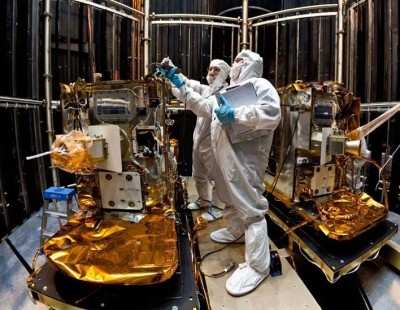Sat, Dec 31, 2011
GRAIL-A Just Hours Away, GRAIL-B Close Behind
NASA's unmanned programs are celebrating the end of 2011 with a
return to the Moon. NASA's Gravity Recovery And Interior Laboratory
(GRAIL)-A spacecraft is within a few hours of its insertion burn
that will place it into lunar orbit.

At the time the spacecraft crossed the milestone at 1:21 p.m.
PST Friday (4:21 p.m. EST), the spacecraft was 30,758 miles from
the moon. Launched aboard the same rocket on Sept. 10, 2011,
GRAIL-A's mirror twin, GRAIL-B, is also closing the gap between
itself and the moon. GRAIL-B is scheduled to perform its lunar
orbit insertion burn on New Year's Day (Jan. 1) at 2:05 p.m. PST
(5:05 p.m. EST).
As they close in on the moon, both orbiters move toward the moon
from the south, flying nearly directly over the lunar south pole.
The lunar orbit insertion burn for GRAIL-A will take approximately
40 minutes to complete and change the spacecraft's velocity by
about 427 mph. GRAIL-B's insertion burn - occurring 25 hours later
-- will last about 39 minutes and is expected to change its
velocity by 430 mph.
The insertion maneuvers will place each orbiter into a near-polar,
elliptical orbit with an orbital period of 11.5 hours. Over the
following weeks, the GRAIL team will execute a series of burns with
each spacecraft to reduce their period down to just under two
hours. At the start of the science phase in March 2012, the two
GRAILs will be in a near-polar, near-circular orbit with an
altitude of about 34 miles.

During the science phase, the moon will rotate three times
underneath the GRAIL orbit. The collection of gravity data over one
complete rotation (27.3 days) is referred to as a Mapping Cycle.
When science collection begins, the spacecraft will transmit radio
signals precisely defining the distance between them as they orbit
the moon in formation. Regional gravitational differences on the
moon are expected to expand and contract that distance. GRAIL
scientists will use these accurate measurements to define the
moon's gravity field. The data will allow mission scientists to
understand what goes on below the surface of our natural satellite.
This information will help us learn more about how the moon, Earth
and other terrestrial planets formed.
NASA's Jet Propulsion Laboratory, Pasadena, Calif., manages the
GRAIL mission. The Massachusetts Institute of Technology,
Cambridge, is home to the mission's principal investigator, Maria
Zuber. The GRAIL mission is part of the Discovery Program managed
at NASA's Marshall Space Flight Center in Huntsville, Ala. Lockheed
Martin Space Systems, Denver, built the spacecraft. JPL is a
division of the California Institute of Technology in Pasadena.
More News
Aero Linx: International Business Aviation Council Ltd IBAC promotes the growth of business aviation, benefiting all sectors of the industry and all regions of the world. As a non->[...]
"During the annual inspection of the B-24 “Diamond Lil” this off-season, we made the determination that 'Lil' needs some new feathers. Due to weathering, the cloth-cove>[...]
Also: Bushcat Woes, Hummingbird 300 SL 4-Seat Heli Kit, Carbon Cub UL The newest Junkers is a faithful recreation that mates a 7-cylinder Verner radial engine to the airframe offer>[...]
Also: Seaplane Pilots Association, Rotax 916’s First Year, Gene Conrad After a decade and a half of struggling with the FAA and other aero-politics, G100UL is in production a>[...]
Also: Martha King Scholarship, Montaer Grows, Textron Updates Pistons, FlySto The FAA is hiring thousands of air traffic controllers, but the window to apply will only be open for >[...]
 ANN's Daily Aero-Linx (04.16.24)
ANN's Daily Aero-Linx (04.16.24) Aero-News: Quote of the Day (04.16.24)
Aero-News: Quote of the Day (04.16.24) Airborne 04.10.24: SnF24!, A50 Heritage Reveal, HeliCycle!, Montaer MC-01
Airborne 04.10.24: SnF24!, A50 Heritage Reveal, HeliCycle!, Montaer MC-01 Airborne 04.12.24: SnF24!, G100UL Is Here, Holy Micro, Plane Tags
Airborne 04.12.24: SnF24!, G100UL Is Here, Holy Micro, Plane Tags Airborne-Flight Training 04.17.24: Feds Need Controllers, Spirit Delay, Redbird
Airborne-Flight Training 04.17.24: Feds Need Controllers, Spirit Delay, Redbird




